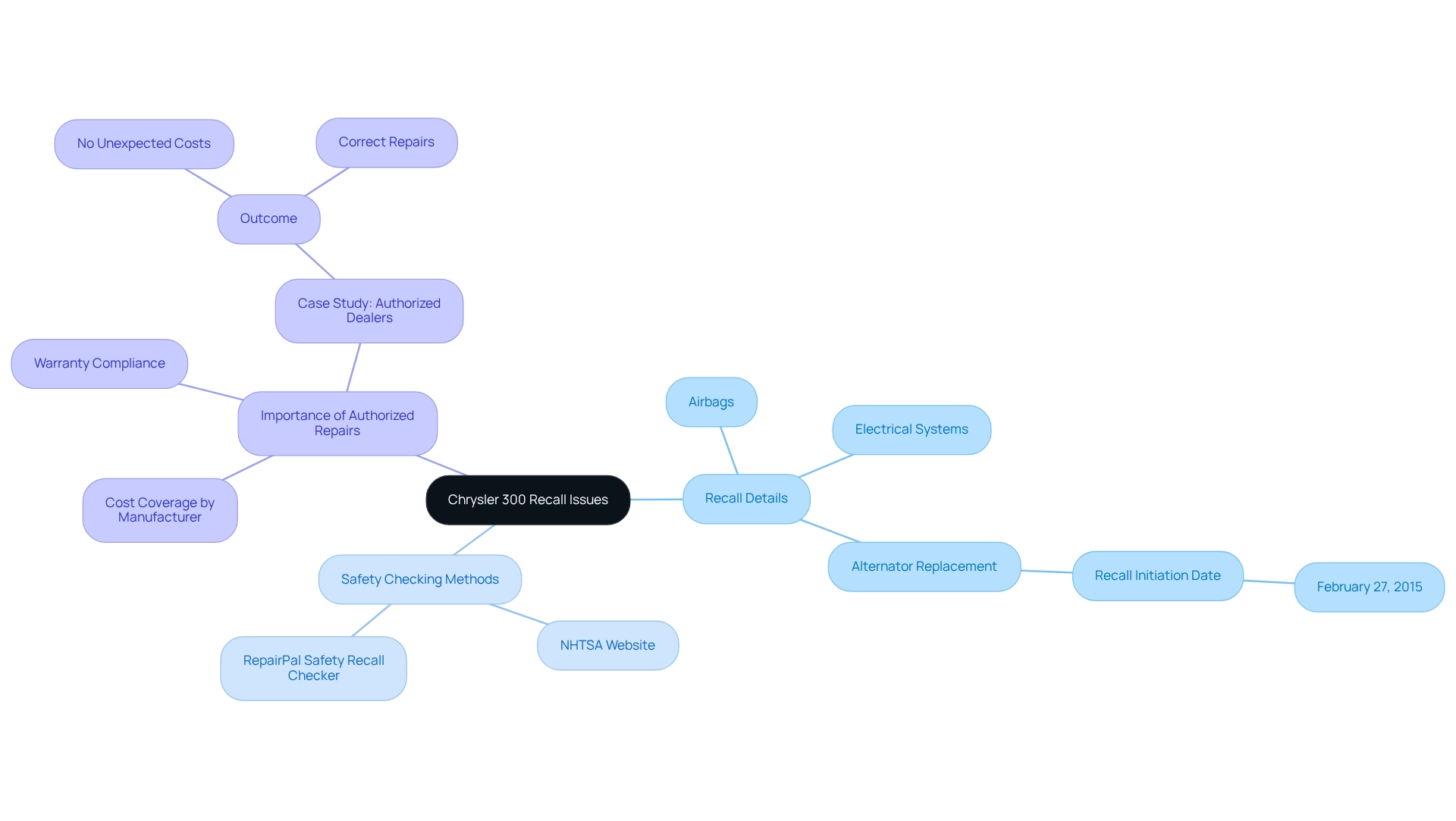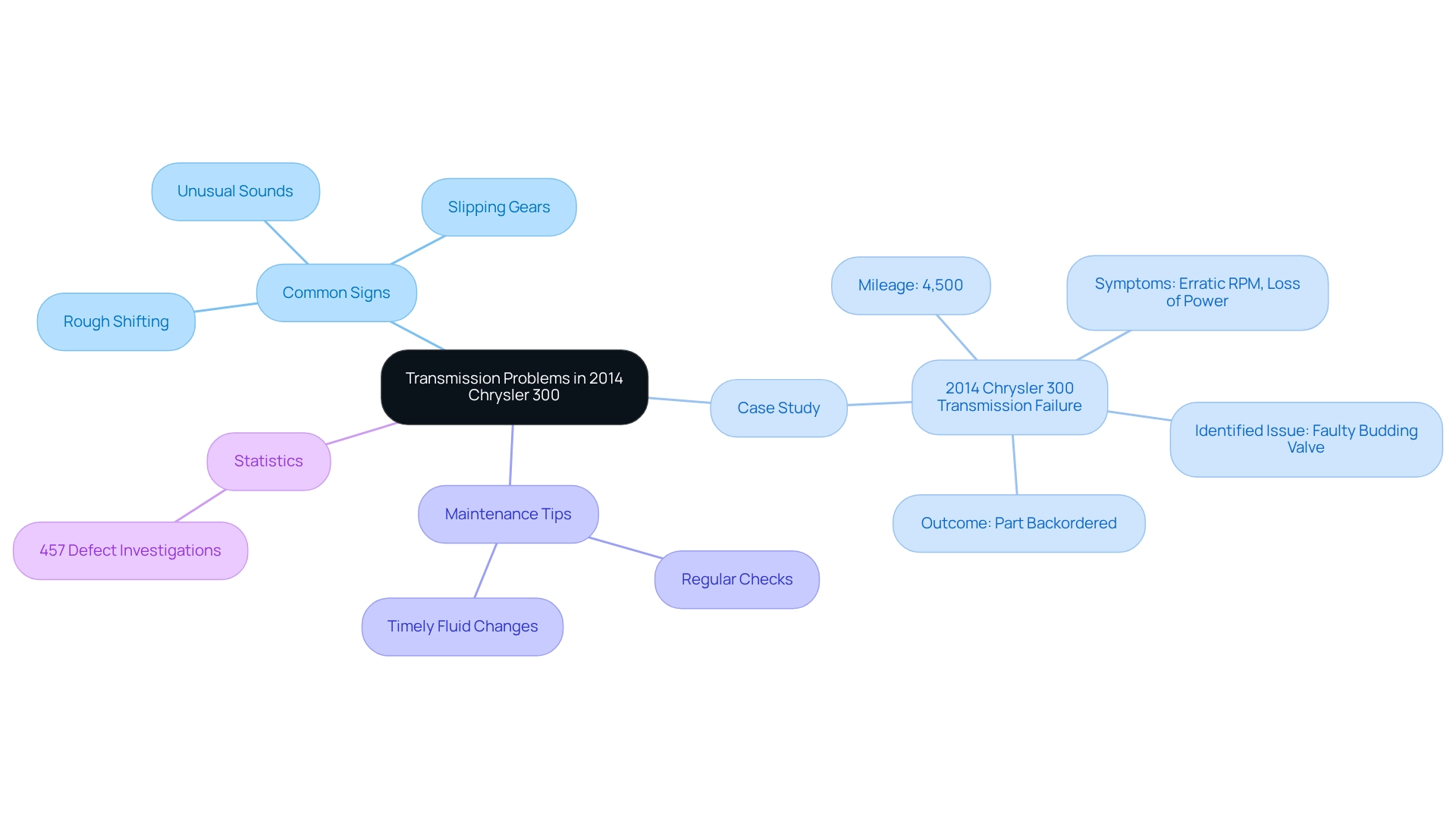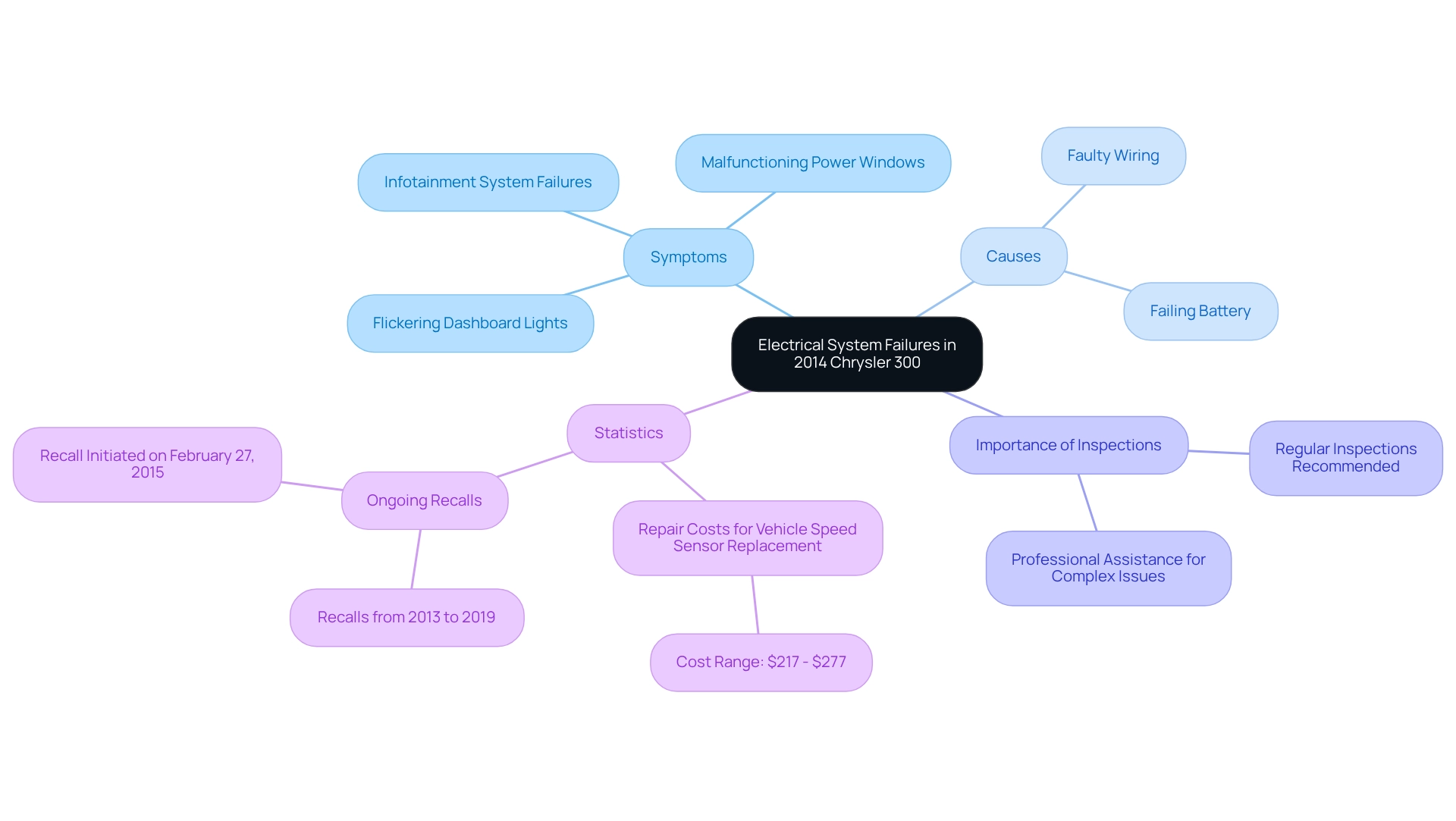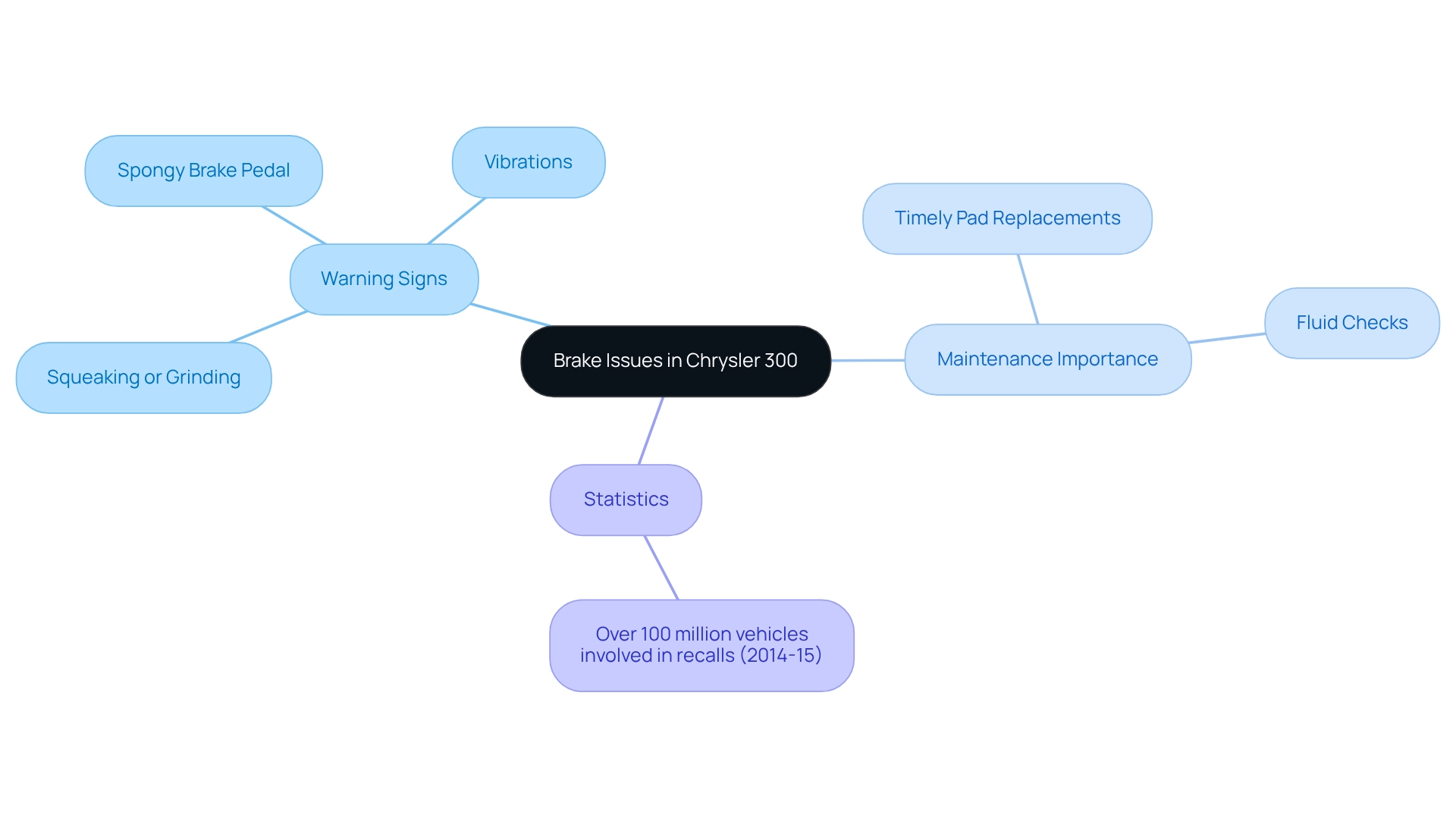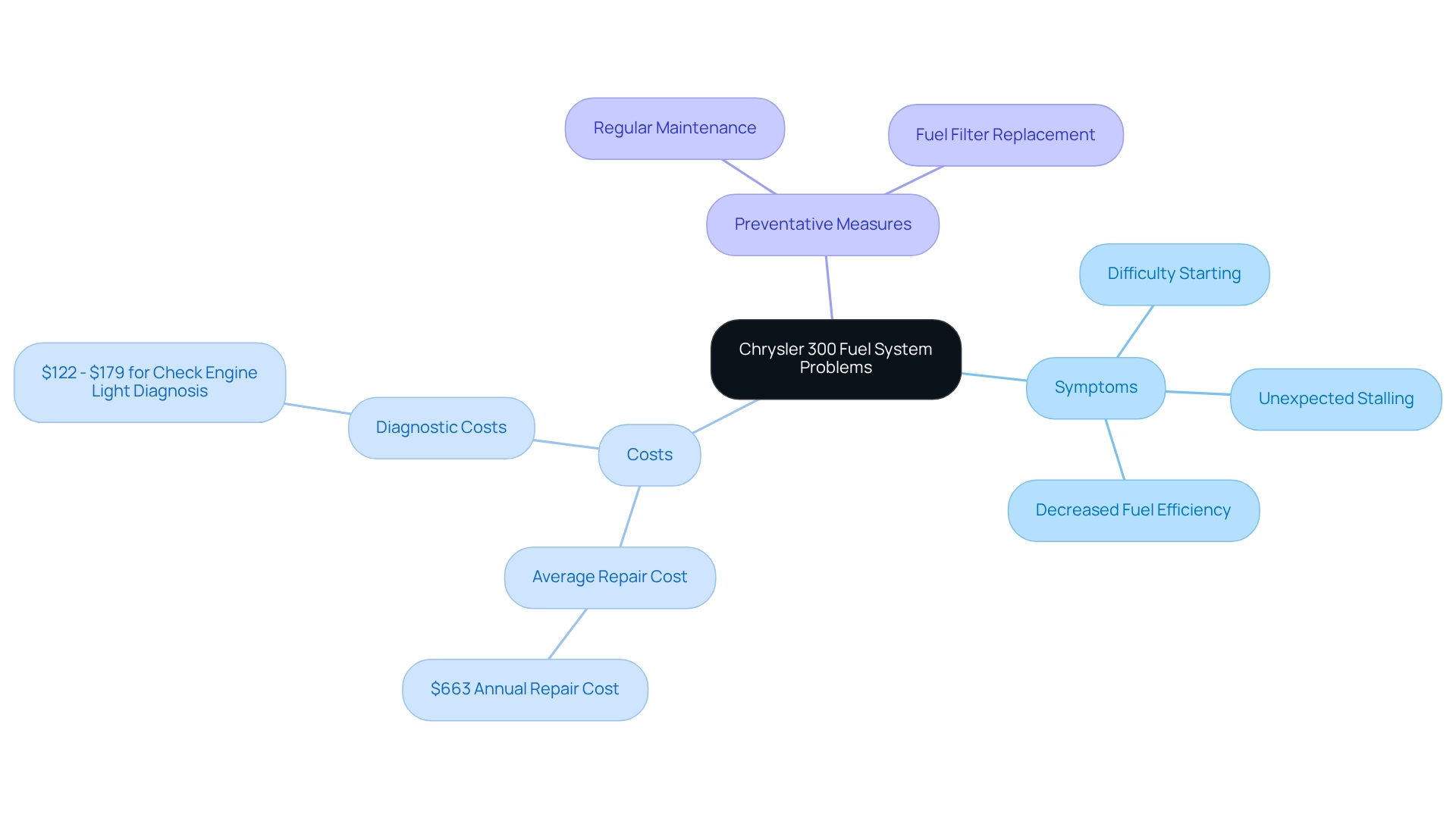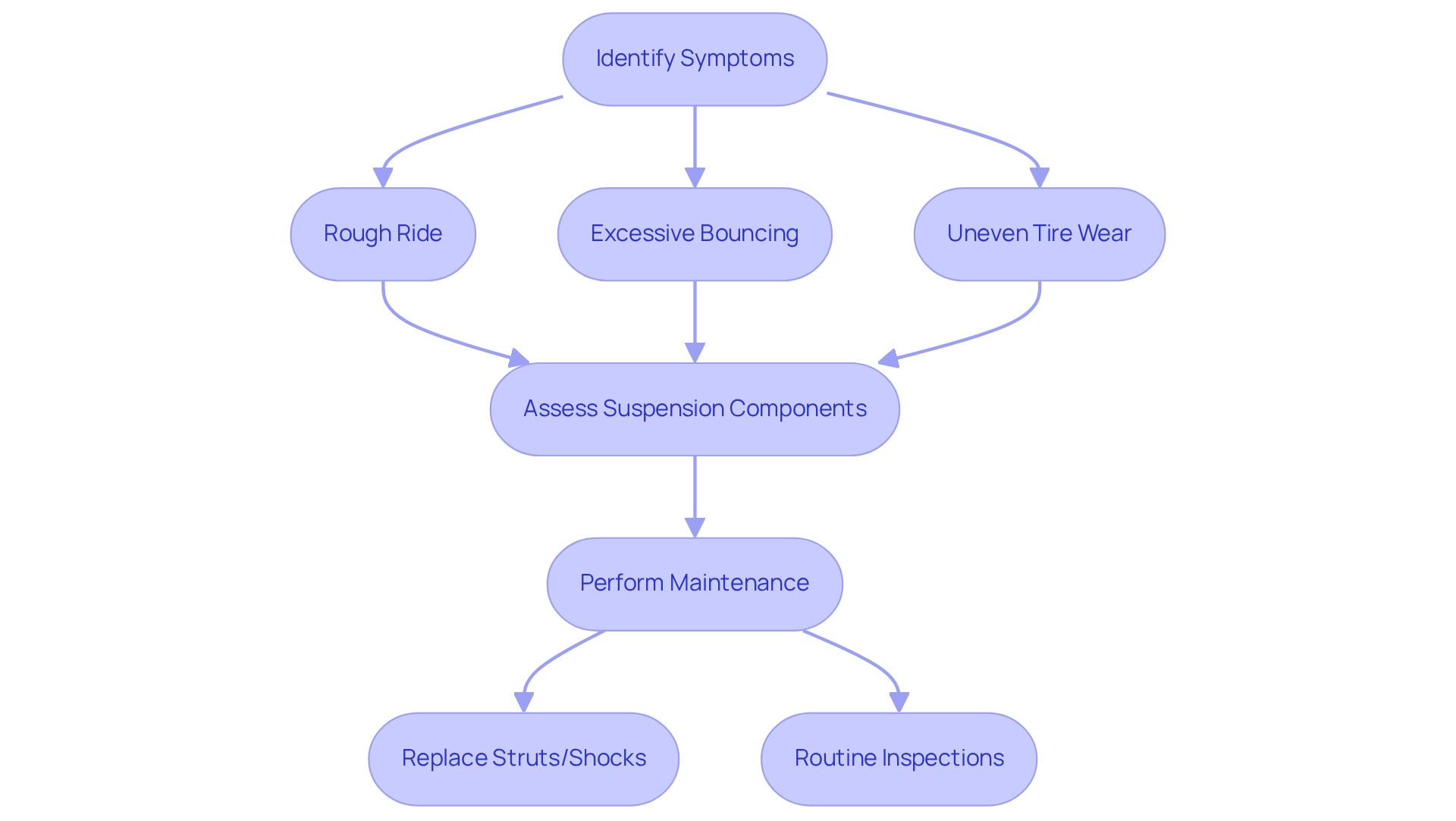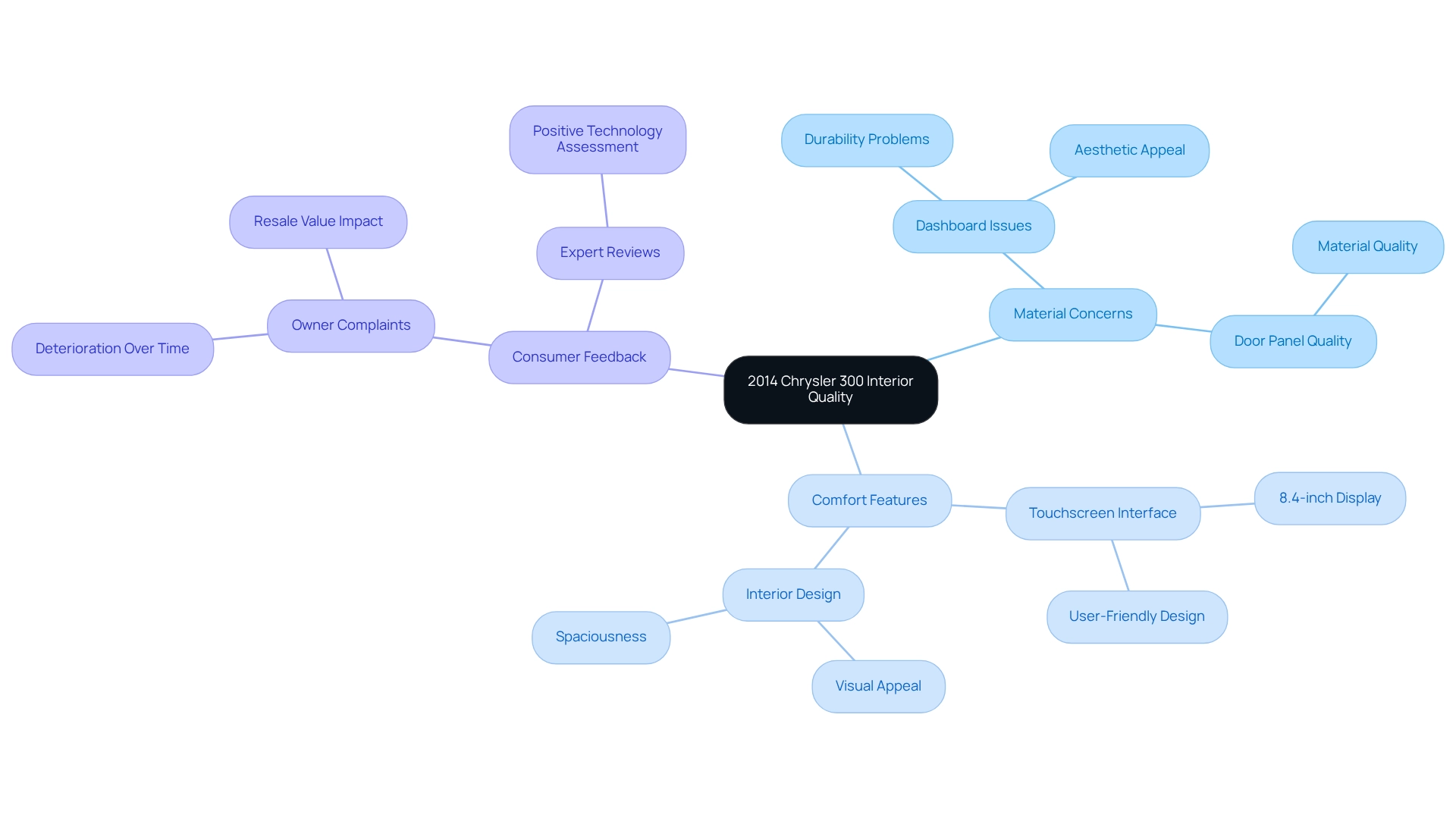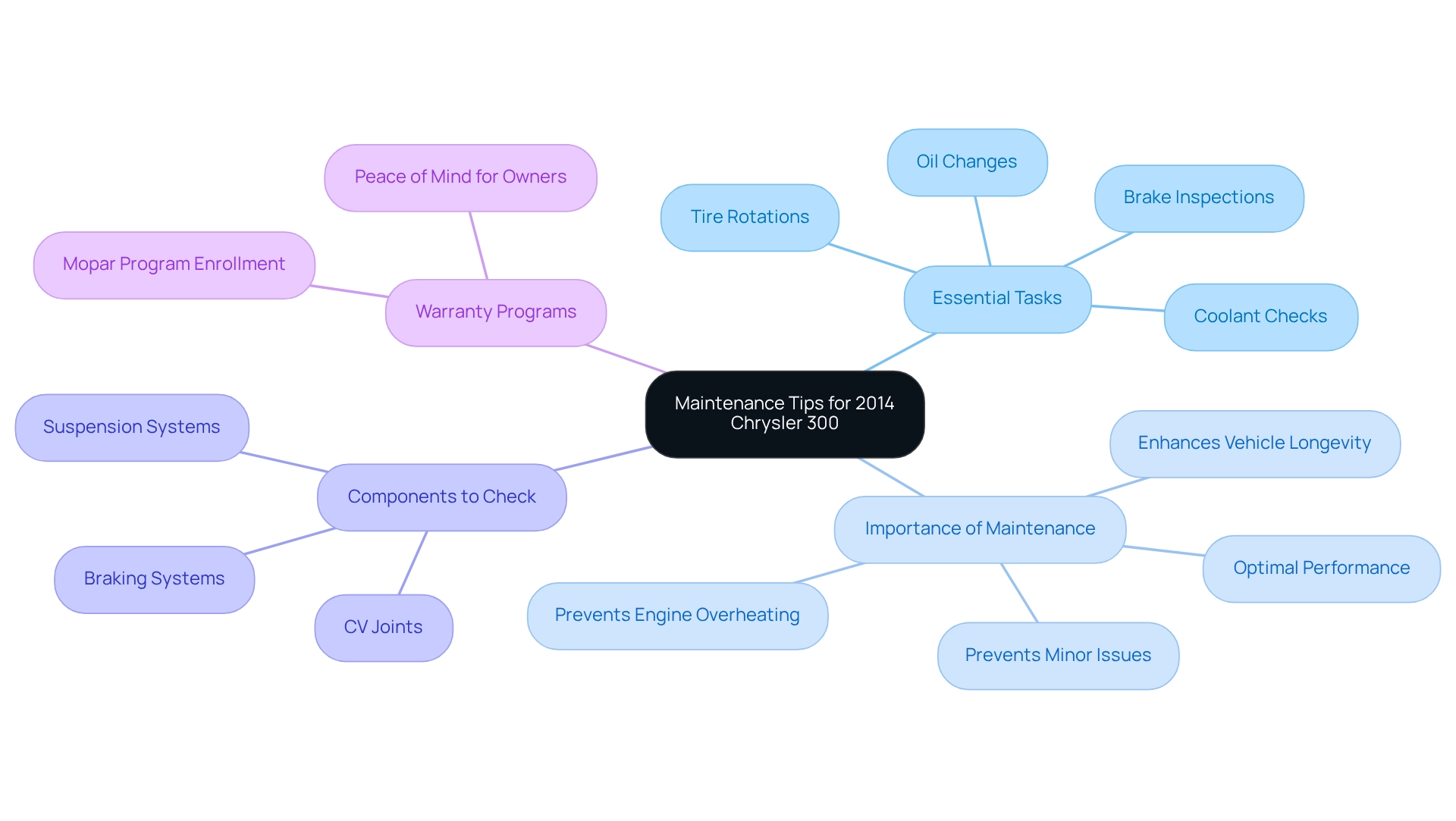10 Common 2014 Chrysler 300 Problems You Should Know
Overview
This article examines the prevalent issues associated with the 2014 Chrysler 300, including:
- Electrical system failures
- Transmission problems
- Safety recalls
Understanding these common problems is crucial for owners. Regular maintenance and prompt inspections are emphasized as essential strategies. These proactive measures not only help mitigate serious safety risks but also prevent costly repairs. Ultimately, ensuring the vehicle’s reliability and performance is a significant benefit of staying ahead of potential issues.
Introduction
In the realm of automotive reliability, the 2014 Chrysler 300 is a vehicle that has garnered both admiration and concern from its owners. Notably, it has faced a series of recalls and reported issues, ranging from critical safety components to performance-related failures. Understanding the nuances of this model is essential for current and prospective owners alike.
Key features of the Chrysler 300 include its advanced safety systems and robust performance capabilities. However, these features come with advantages that may be overshadowed by common issues such as transmission troubles and electrical system failures. Each aspect highlights the importance of vigilance and regular maintenance.
This article delves into the common problems associated with the Chrysler 300, offering insights into identifying warning signs and implementing proactive measures to ensure safety and longevity on the road. By staying informed, owners can navigate the complexities of vehicle upkeep. Ultimately, this knowledge enhances their driving experience and safeguards their investment.
Chrysler 300 Recall Issues: Understanding Current Safety Concerns
The 2014 Chrysler 300 problems have resulted in multiple recalls, particularly related to critical safety components such as airbags and electrical systems. A significant recall initiated on February 27, 2015, specifically addressed alternator replacements in certain models from 2011 to 2014, highlighting the necessity for timely repairs.
How can owners ensure their vehicle’s safety? They are encouraged to regularly check their automobile’s status through the National Highway Traffic Safety Administration (NHTSA) website or the brand’s recall page using their Vehicle Identification Number (VIN). Additionally, the RepairPal Safety Recall Checker offers a straightforward method to identify any open recalls. This proactive strategy not only helps mitigate serious safety risks but also prevents unexpected repair costs.
Furthermore, utilizing authorized dealers for any recall repairs is crucial. A case study emphasizes that these repairs must be conducted at authorized dealers to guarantee that costs are covered by the manufacturer and to maintain warranty compliance. By staying informed and acting promptly, owners can protect their vehicles and enhance their safety on the road.
Transmission Problems: Identifying Signs of Failure in the Chrysler 300
Common signs of transmission issues that indicate 2014 Chrysler 300 problems include:
- Rough shifting
- Slipping gears
- Unusual sounds, such as grinding or whining during gear changes
These symptoms can indicate underlying 2014 Chrysler 300 problems that may lead to more severe issues if not addressed promptly. For example, a notable case involving 2014 Chrysler 300 problems included a vehicle model 300 with only 4,500 miles experiencing complete transmission failure, attributed to a faulty Budding Valve. Such incidents emphasize the importance of attentiveness in monitoring automobile performance.
If you observe any of these symptoms, it is essential to have the transmission examined by a qualified mechanic. Regular maintenance, including timely fluid changes, can significantly prolong the life of the transmission. Did you know that the 2014 Chrysler 300 problems have resulted in 457 defect investigations? This statistic highlights the frequency of 2014 Chrysler 300 problems, particularly those related to transmission concerns in this vehicle. As the CarParts.com Research Team states, ‘Guided by CarParts.com’s thorough editorial process, our team strives to produce guides and resources DIYers and casual car owners can trust.’ By remaining knowledgeable and proactive—such as maintaining a log and seeking advice from a mechanic if symptoms persist—you can reduce the risk of expensive repairs and ensure your transportation remains dependable.
Electrical System Failures: Common Symptoms in the 2014 Chrysler 300
Owners often report 2014 Chrysler 300 problems related to electrical issues, such as flickering dashboard lights, malfunctioning power windows, and infotainment system failures. These issues are often linked to faulty wiring or a failing battery, leading to significant inconveniences. Symptoms such as intermittent electrical failures may indicate more serious problems within the vehicle’s electrical system. Regular inspections are crucial; they can help identify these problems early, potentially saving owners from costly repairs down the line.
According to statistics, the 2014 Chrysler 300 problems, particularly those related to electrical system failures, rank among the most frequent grievances, with a notable increase in reported issues over the years. Recalls related to electrical system failures have been ongoing, with significant recalls spanning from 2013 to 2019, highlighting persistent safety concerns. For instance, the automaker initiated a recall on February 27, 2015, for specific models, including the 2014 model 300, due to 2014 Chrysler 300 problems related to possible alternator malfunctions that could exacerbate electrical issues.
Expert opinions indicate that addressing electrical problems often necessitates thorough inspections, including disassembly and cleaning of connectors to ensure proper connections, as outlined in the case study titled “Procedures for Electrical System Inspections.” In complex cases, professional assistance is recommended, as non-certified mechanics may struggle to resolve intricate electrical issues effectively. As noted by Asbury Automotive Group, “All of our dealers will diagnose the 2014 model 300 Electrical System recall and repair it at no cost in accordance with OEM guidelines and instructions.” This underscores the importance of consulting qualified technicians when facing ongoing electrical issues in the 300 model, ensuring repairs adhere to OEM guidelines. Furthermore, potential repair expenses for associated concerns, such as Vehicle Speed Sensor Replacement, range from $217 to $277, further emphasizing the necessity for prompt inspections and repairs.
Brake Issues: Recognizing Warning Signs in the Chrysler 300
Warning signs of 2014 Chrysler 300 problems can manifest in various ways related to braking. Drivers might experience:
- Squeaking or grinding noises
- A spongy brake pedal
- Vibrations during braking
These symptoms serve as critical indicators of 2014 Chrysler 300 problems that necessitate immediate inspection of the braking system. Regular maintenance, which includes timely pad replacements and fluid checks, is essential for ensuring safe driving.
Did you know that over 100 million new and pre-owned automobiles were involved in safety-related recalls in 2014-15? This statistic highlights the prevalence of brake problems, particularly the 2014 Chrysler 300 problems, and underscores the need for drivers to remain vigilant.
Furthermore, a case study on the Chrysler 300 cruise control recall illustrates the importance of promptly addressing any warning signs, as certain defects can lead to significant safety concerns.
Remember, ‘Regular maintenance of automobiles is crucial for safety and performance.’ This emphasizes the necessity for drivers to closely monitor their brake performance. By addressing these warning signs promptly, drivers can prevent more severe complications and enhance overall transportation safety.
Cooling System Failures: Preventing Overheating in the Chrysler 300
Various factors, such as a malfunctioning thermostat, a leaking radiator, or insufficient coolant levels, can lead to overheating in the 2014 Chrysler 300 problems. Regular maintenance is essential; drivers should routinely check coolant levels and inspect the radiator for any signs of leakage. Ignoring symptoms of overheating can lead to severe consequences, including complete engine failure, resulting in costly repairs. If the temperature gauge indicates a rise above normal, it is crucial to pull over immediately and allow the engine to cool before investigating further.
Statistics indicate that cooling system failures are a common issue in certain automobiles, with a significant percentage of owners reporting overheating troubles. For example, in 2025, discussions surrounding the 2014 Chrysler 300 problems, particularly its cooling system failures, have gained traction, underscoring the importance of proactive measures. Expert guidance suggests that addressing small concerns promptly can prevent more serious problems in the future. The projected cost for diagnosing a coolant leak ranges from $60 to $88, providing clear insight into potential repair expenses linked to cooling system issues.
Real-world examples emphasize the urgency of timely repairs. Similar to older Toyota Supra models, where a cracked radiator can lead to overheating and coolant leakage, the Chrysler 300 can experience similar failures if not monitored closely. As Danny, a user of JustAnswer, noted, “I have been using various online services for the past 20 years, and I can’t say that I had a better experience ever before than I had with JustAnswer. Amazingly fast, detailed, and knowledgeable answers solved all of the questions I had, and some questions I didn’t even know I had.” This highlights the importance of seeking professional guidance for automotive issues. By remaining vigilant and addressing potential concerns promptly, drivers can significantly reduce the risk of overheating and ensure the longevity of their vehicle.
Fuel System Problems: Troubleshooting Issues in the Chrysler 300
The 2014 Chrysler 300 problems are known to include several common fuel system issues that can significantly impact performance. Challenges reported by owners include:
- Difficulty starting the car
- Unexpected stalling
- A marked decrease in fuel efficiency
These symptoms are frequently associated with a failing fuel pump, a clogged fuel filter, or malfunctioning fuel injectors.
Statistics indicate that fuel efficiency problems are prevalent in certain vehicles, with many owners experiencing a drop in miles per gallon due to these issues. For instance, the average annual repair cost for addressing 2014 Chrysler 300 problems hovers around $663, often including expenses related to fuel system repairs. Additionally, the national average cost for diagnosing check engine light issues ranges from $122.00 to $179.00, highlighting potential expenses tied to identifying fuel system problems.
To address these concerns, regular maintenance is essential. Replacing the fuel filter at recommended intervals can help prevent clogs and ensure optimal fuel flow. Moreover, addressing any signs of fuel system failure promptly can save on costly repairs in the future. In May 2025, reports emphasized ongoing concerns regarding stalling issues, highlighting 2014 Chrysler 300 problems and underscoring the importance for owners to stay vigilant about their vehicle’s performance. Real-life accounts from owners demonstrate that timely troubleshooting can lead to effective solutions, including software updates for shifting issues or lubricating the lower seal on the steering shaft.
Expert insights suggest that recognizing typical signs of fuel system problems—such as rough idling, reduced acceleration, and engine misfires—can empower owners to take proactive steps in maintaining their vehicles. By remaining informed and addressing these issues swiftly, 300 owners can improve their driving experience and avoid more serious complications.
Suspension Issues: Understanding the Impact on Chrysler 300 Performance
Suspension issues in the 2014 model can significantly affect ride quality and overall vehicle performance. Common symptoms include a rough ride, excessive bouncing, and uneven tire wear, often indicating wear in critical components such as struts, shocks, or bushings. For instance, clunking or knocking sounds when going over bumps may signal considerable wear in suspension parts, necessitating prompt attention to avert further complications.
Routine inspections and maintenance of the suspension system are essential for enhancing ride comfort and handling. It is generally advised that struts and shocks be replaced as pairs to sustain optimal performance. Neglecting these components can result in unsafe driving conditions, as demonstrated in a case study that identifies symptoms of a failing suspension system, which include sloppy steering and diving during braking. This analysis underscores the importance of recognizing these symptoms to promote timely evaluations and repairs, especially in light of the 2014 Chrysler 300 problems reported in May 2025, where numerous owners expressed concerns about suspension issues and ride comfort.
Expert opinions stress the necessity of addressing these issues promptly to ensure safety and reliability. As noted by RepairPal, shock absorbers are typically easier and safer to replace, making it a viable option for DIY mechanics. By being vigilant about these symptoms and performing timely inspections, 300 owners can greatly enhance their driving experience and extend the lifespan of their vehicles.
Interior Quality Concerns: Evaluating Comfort in the 2014 Chrysler 300
The 2014 model 300 is frequently praised for its spacious interior. However, some owners have raised concerns about the quality of materials, which are among the 2014 Chrysler 300 problems, particularly regarding the dashboard and door panels. Reports suggest that the dashboard material may not endure wear as well as anticipated, resulting in complaints about its durability and aesthetic appeal. While routine cleaning and maintenance can mitigate some of these issues, potential buyers should weigh these factors against the overall value of the vehicle.
Consumer Reports highlights that Chrysler vehicles, including the 300, have faced reliability challenges, with eight recalls affecting models from 2009 to 2016. Notably, the recall for these cars began on February 27, 2015, specifically addressing alternator replacement at no cost to owners. This information underscores the necessity of evaluating material quality and comfort when contemplating a purchase. Expert assessments indicate that although the 300’s interior design is visually attractive, the selection of materials may detract from the perceived luxury and comfort. Edmunds states, “On the technology front, the standard 8.4-inch touchscreen interface is one of our favorites, combining large buttons and clear graphics with a logical menu structure,” which highlights some of the vehicle’s strengths.
Real-life accounts from owners further illustrate these concerns, with some mentioning that the dashboard’s finish deteriorates over time, which are among the 2014 Chrysler 300 problems that affect the vehicle’s resale value. Therefore, prospective buyers should thoroughly examine the interior quality of the 2014 model, as well as the 2014 Chrysler 300 problems related to comfort and material durability to ensure a satisfying ownership experience. It is advisable for buyers to inspect the interior materials during a test drive to make an informed decision.
Tire Wear Problems: Ensuring Safety in the Chrysler 300
Tire maintenance is essential for ensuring safety and performance, particularly in light of the 2014 Chrysler 300 problems. Excessive tire wear can stem from several factors, including misalignment, improper inflation, and worn suspension components. To maintain optimal tire health, it is essential to regularly check tire pressure—ideally on a monthly basis—and monitor tread depth.
Why is Regular Maintenance Important?
Rotating tires every 5,000 to 7,500 miles promotes even wear and significantly extends tire life, which averages around 50,000 miles for this model, potentially helping to minimize 2014 Chrysler 300 problems under normal driving conditions. If you notice uneven wear patterns, it is advisable to have your alignment assessed by a professional. Additionally, being mindful of driving conditions can help prevent premature tire wear.
What Are the Current Deals?
For budget-conscious shoppers, current deals include discounts on Nitto Terra Grappler AT tires and rebates on Goodyear and Continental tires. Taking advantage of these savings can enhance your tire maintenance experience without straining your budget.
To ensure a smoother and more reliable driving experience, consider scheduling regular tire maintenance checks. This proactive approach not only safeguards your vehicle but also maximizes your investment in tire quality.
Maintenance Tips: Keeping Your 2014 Chrysler 300 in Optimal Condition
To keep your 2014 Chrysler 300 problems at bay, it is crucial to adhere to a consistent maintenance schedule that includes essential tasks such as:
- Oil changes
- Tire rotations
- Brake inspections
- Coolant checks
Why is this important? Consistently checking your automobile’s performance allows you to swiftly respond to any warning lights or strange noises, preventing minor issues from escalating into significant repairs. By utilizing high-quality components and fluids, you not only enhance the longevity of your vehicle but also contribute to its optimal performance. For instance, prompt radiator upkeep can avert engine overheating, protecting against major damage and ensuring your vehicle operates smoothly.
With proper care, this model can potentially reach 200,000 miles or more, making regular maintenance a worthwhile investment. Additionally, the warranty programs from the automaker provide reassurance for owners regarding repairs and upkeep, further emphasizing the significance of a systematic maintenance schedule. During maintenance visits, technicians will examine various components, including:
- CV joints
- Suspension systems
- Braking systems
As detailed in your car owner’s manual, being aware of the 2014 Chrysler 300 problems can help budget-conscious buyers plan for their vehicle maintenance. Remember to schedule regular check-ups and consult your owner’s manual for specific maintenance schedules to keep your Chrysler 300 in optimal condition.
Conclusion
The 2014 Chrysler 300 is recognized for its performance and features, yet it faces various reliability concerns that both potential and current owners must navigate. With multiple recalls concerning critical safety components, such as airbags and electrical systems, it is essential for owners to remain informed and proactive. Regular checks through resources like the NHTSA website can help mitigate safety risks and prevent unexpected expenses.
Common issues, including transmission problems, electrical system failures, and brake concerns, underscore the importance of vigilance in monitoring vehicle performance. Identifying early warning signs—such as rough shifting or flickering dashboard lights—can prompt timely inspections and repairs, ultimately safeguarding the vehicle’s longevity and enhancing safety on the road.
Furthermore, addressing cooling system failures, fuel system problems, and suspension issues is crucial for maintaining the comfort and reliability of the Chrysler 300. Owners are encouraged to adhere to a consistent maintenance schedule, which not only prolongs the vehicle’s lifespan but also ensures optimal performance.
In summary, by staying informed and proactive regarding the common problems associated with the 2014 Chrysler 300, owners can significantly enhance their driving experience and protect their investment. Regular maintenance and timely repairs are vital for navigating the complexities of vehicle ownership, ultimately leading to safer and more reliable journeys.
Frequently Asked Questions
What are the main problems associated with the 2014 Chrysler 300?
The 2014 Chrysler 300 has experienced multiple problems, particularly with safety components such as airbags and electrical systems, leading to several recalls. A significant recall on February 27, 2015, focused on alternator replacements for models from 2011 to 2014.
How can owners check the safety status of their 2014 Chrysler 300?
Owners can check their vehicle’s safety status by visiting the National Highway Traffic Safety Administration (NHTSA) website or the brand’s recall page using their Vehicle Identification Number (VIN). The RepairPal Safety Recall Checker is also available for identifying any open recalls.
Why is it important to use authorized dealers for recall repairs?
It is crucial to utilize authorized dealers for recall repairs to ensure that the costs are covered by the manufacturer and to maintain warranty compliance. Repairs done at authorized dealers guarantee adherence to manufacturer standards.
What are common signs of transmission issues in the 2014 Chrysler 300?
Common signs of transmission issues include rough shifting, slipping gears, and unusual sounds such as grinding or whining during gear changes. These symptoms may indicate serious underlying problems.
What should owners do if they notice transmission issues?
If owners observe any transmission symptoms, they should have the transmission examined by a qualified mechanic. Regular maintenance, including timely fluid changes, can also help prolong the life of the transmission.
What are the statistics regarding transmission problems in the 2014 Chrysler 300?
There have been 457 defect investigations related to the 2014 Chrysler 300, highlighting the frequency of transmission concerns in this vehicle.
What electrical issues are commonly reported in the 2014 Chrysler 300?
Owners often report electrical issues such as flickering dashboard lights, malfunctioning power windows, and infotainment system failures, usually linked to faulty wiring or a failing battery.
What is the significance of regular inspections for electrical issues in the 2014 Chrysler 300?
Regular inspections are essential as they can help identify electrical problems early, potentially preventing costly repairs. Addressing these issues often requires thorough inspections and, in complex cases, professional assistance.
What should be done if electrical problems persist in the 2014 Chrysler 300?
If electrical problems persist, it is recommended to consult qualified technicians to ensure repairs adhere to OEM guidelines. Authorized dealers can diagnose and repair electrical system recalls at no cost.
What are the potential repair costs for electrical issues in the 2014 Chrysler 300?
Potential repair expenses for issues related to the electrical system, such as Vehicle Speed Sensor Replacement, can range from $217 to $277.


